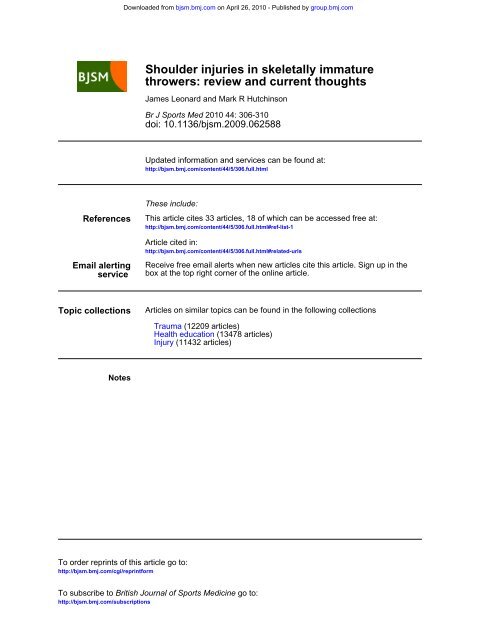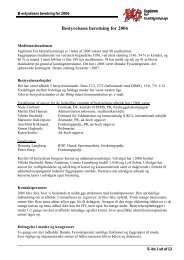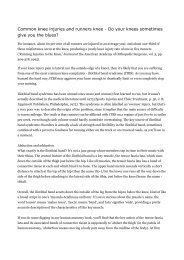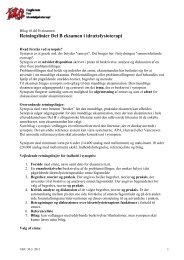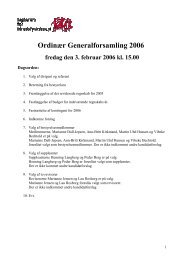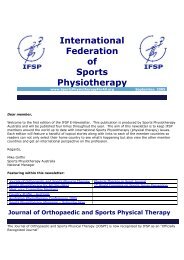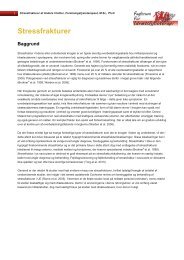review and current thoughts Shoulder injuries in skeletally immature
review and current thoughts Shoulder injuries in skeletally immature
review and current thoughts Shoulder injuries in skeletally immature
You also want an ePaper? Increase the reach of your titles
YUMPU automatically turns print PDFs into web optimized ePapers that Google loves.
Downloaded from bjsm.bmj.com on April 26, 2010 - Published by group.bmj.com<br />
<strong>Shoulder</strong> <strong><strong>in</strong>juries</strong> <strong>in</strong> <strong>skeletally</strong> <strong>immature</strong><br />
throwers: <strong>review</strong> <strong>and</strong> <strong>current</strong> <strong>thoughts</strong><br />
James Leonard <strong>and</strong> Mark R Hutch<strong>in</strong>son<br />
Br J Sports Med 2010 44: 306-310<br />
doi: 10.1136/bjsm.2009.062588<br />
Updated <strong>in</strong>formation <strong>and</strong> services can be found at:<br />
http://bjsm.bmj.com/content/44/5/306.full.html<br />
References<br />
Email alert<strong>in</strong>g<br />
service<br />
These <strong>in</strong>clude:<br />
This article cites 33 articles, 18 of which can be accessed free at:<br />
http://bjsm.bmj.com/content/44/5/306.full.html#ref-list-1<br />
Article cited <strong>in</strong>:<br />
http://bjsm.bmj.com/content/44/5/306.full.html#related-urls<br />
Receive free email alerts when new articles cite this article. Sign up <strong>in</strong> the<br />
box at the top right corner of the onl<strong>in</strong>e article.<br />
Topic collections<br />
Articles on similar topics can be found <strong>in</strong> the follow<strong>in</strong>g collections<br />
Trauma (12209 articles)<br />
Health education (13478 articles)<br />
Injury (11432 articles)<br />
Notes<br />
To order repr<strong>in</strong>ts of this article go to:<br />
http://bjsm.bmj.com/cgi/repr<strong>in</strong>tform<br />
To subscribe to British Journal of Sports Medic<strong>in</strong>e go to:<br />
http://bjsm.bmj.com/subscriptions
<strong>Shoulder</strong> <strong><strong>in</strong>juries</strong> <strong>in</strong> athletes<br />
Downloaded from bjsm.bmj.com on April 26, 2010 - Published by group.bmj.com<br />
<strong>Shoulder</strong> <strong><strong>in</strong>juries</strong> <strong>in</strong> <strong>skeletally</strong> <strong>immature</strong> throwers:<br />
<strong>review</strong> <strong>and</strong> <strong>current</strong> <strong>thoughts</strong><br />
James Leonard, Mark R Hutch<strong>in</strong>son<br />
University of Ill<strong>in</strong>ois at Chicago,<br />
Chicago, IL 60612, USA<br />
Correspondence to<br />
Professor Mark R Hutch<strong>in</strong>son,<br />
Department of Orthopaedics<br />
<strong>and</strong> Sports Medic<strong>in</strong>e,<br />
University of Ill<strong>in</strong>ois at Chicago,<br />
835 South Wolcott, 270<br />
Medical Sciences Build<strong>in</strong>g,<br />
Chicago, IL 60612, USA;<br />
mhutch@uic.edu<br />
ABSTRACT<br />
The <strong>in</strong>cidence of shoulder <strong><strong>in</strong>juries</strong> <strong>in</strong> the paediatric<br />
athletic population cont<strong>in</strong>ues to <strong>in</strong>crease with <strong>in</strong>creased<br />
participation particularly <strong>in</strong> throw<strong>in</strong>g <strong>and</strong> overhead<br />
sports. While soft tissue <strong><strong>in</strong>juries</strong> can occur, the physis<br />
rema<strong>in</strong>s the weak l<strong>in</strong>k <strong>and</strong> site of <strong>in</strong>jury <strong>in</strong> many cases.<br />
Injury prevention targets proper throw<strong>in</strong>g mechanics<br />
<strong>and</strong> the avoidance of overuse <strong><strong>in</strong>juries</strong> by monitor<strong>in</strong>g the<br />
amount of tra<strong>in</strong><strong>in</strong>g <strong>and</strong> number of throws these young<br />
athletes are exposed to.<br />
The <strong>in</strong>cidence of shoulder <strong><strong>in</strong>juries</strong> <strong>in</strong> the paediatric<br />
population is <strong>in</strong>creas<strong>in</strong>g as participation <strong>in</strong> recreational<br />
<strong>and</strong> competitive leagues grows. These<br />
<strong><strong>in</strong>juries</strong> are caused by either an acute traumatic<br />
event or, more commonly, chronic overuse from<br />
repetitive overhead motion. Rather than the softtissue<br />
or ligamentous <strong><strong>in</strong>juries</strong> commonly seen <strong>in</strong><br />
adult shoulder <strong><strong>in</strong>juries</strong>, the weak l<strong>in</strong>k affected<br />
<strong>in</strong> paediatric shoulder pathology tends to be the<br />
develop<strong>in</strong>g physis. Comb<strong>in</strong>ed with cont<strong>in</strong>ued<br />
development of strength, coord<strong>in</strong>ation <strong>and</strong> physical<br />
skill, the paediatric shoulder offers dist<strong>in</strong>ctive<br />
challenges to the sports medic<strong>in</strong>e physician.<br />
DEVELOPMENTAL ANATOMY<br />
Proximal humerus<br />
The proximal humerus consists of three ossification<br />
centres: the humeral head, the greater tuberosity<br />
<strong>and</strong> the lesser tuberosity (figure 1). By 5–7<br />
years of age, these centres comb<strong>in</strong>e to form a s<strong>in</strong>gle<br />
proximal humeral epiphysis. This physis contributes<br />
80% of the longitud<strong>in</strong>al growth to the shoulder,<br />
allow<strong>in</strong>g for a significant amount of growth<br />
<strong>and</strong> remodell<strong>in</strong>g. Fusion of the humeral epiphysis<br />
to the shaft occurs between the ages of 14 <strong>and</strong> 17<br />
years <strong>in</strong> girls <strong>and</strong> 16–18 years <strong>in</strong> boys. 1 2<br />
first appear at 1 year of age <strong>and</strong> fuse by the age of<br />
15–16 years. An ossification centre at the tip of the<br />
coracoid process sometimes appears <strong>and</strong> fails to<br />
fuse, be<strong>in</strong>g mis<strong>in</strong>terpreted as a fracture. The acromion<br />
consists of two to five ossification centres<br />
that appear at puberty <strong>and</strong> fuse at approximately<br />
22 years of age. Failure to fuse of these acromial<br />
physes has been termed an ‘os acromiale’ <strong>and</strong> can<br />
lead to pa<strong>in</strong> <strong>in</strong> the mature athlete. The glenoid<br />
fossa consists of two ossification centres, <strong>and</strong> the<br />
vertebral border <strong>and</strong> <strong>in</strong>ferior angle of the scapula<br />
each conta<strong>in</strong> one. These centres typically appear<br />
around puberty, fus<strong>in</strong>g by 22 years of age. 2<br />
ACUTE SHOULDER INJURIES<br />
Traumatic <strong><strong>in</strong>juries</strong> to the shoulder (fractures <strong>and</strong><br />
dislocations) have a very low <strong>in</strong>cidence; however,<br />
their frequency is relatively more common dur<strong>in</strong>g<br />
athletic activities. 4 The mechanism of <strong>in</strong>jury<br />
usually <strong>in</strong>volves a forceful collision, fall onto an<br />
outstretched arm, or a sudden wrench<strong>in</strong>g movement.<br />
The resultant <strong>in</strong>jury most commonly is a<br />
glenohumeral dislocation, although fractures of<br />
the clavicle <strong>and</strong> proximal humerus also occur.<br />
306<br />
Clavicle<br />
The clavicle consists of a lateral <strong>and</strong> medial ossification<br />
centre (figure 2). The medial ossification<br />
centre provides 80% of the longitud<strong>in</strong>al growth to<br />
the clavicle, <strong>and</strong> is one of the last physes to close<br />
<strong>in</strong> the body, sometime between the ages of 22 <strong>and</strong><br />
25 years. 2 The lateral ossification centre is rarely<br />
identified radiographically, as it ossifies <strong>and</strong> fuses<br />
over a period of a few months at approximately 19<br />
years of age. 3 Identification of this physis is often<br />
confused with a fracture.<br />
Scapula<br />
The scapula consists of several ossification centres<br />
that are highly variable <strong>in</strong> terms of number<br />
<strong>and</strong> position (figure 2). The coracoid process<br />
consists of two to three ossification centres that<br />
Figure 1 Proximal humeral ossifi cation centres.<br />
The humeral head ossifi cation centre is usually<br />
identifi ed after 6 months of age. The great tuberosity<br />
follows between 7 months <strong>and</strong> 3 years, <strong>and</strong> the lesser<br />
tuberosity between 2 <strong>and</strong> 5 years. These centres<br />
fuse between the ages of 5 <strong>and</strong> 7 years to compose<br />
the proximal humeral epiphysis. Reproduced with<br />
permission from O’Brien et al. 2<br />
Br J Sports Med 2010;44:306–310. doi:10.1136/bjsm.2009.062588
Downloaded from bjsm.bmj.com on April 26, 2010 - Published by group.bmj.com<br />
<strong>Shoulder</strong> <strong><strong>in</strong>juries</strong> <strong>in</strong> athletes<br />
Figure 2 Left: Clavicle with medial<br />
<strong>and</strong> lateral ossifi cation centres.<br />
Right: Scapular ossifi cation centres<br />
identifi ed on the vertebral border <strong>and</strong><br />
<strong>in</strong>ferior angle. Two ossifi cation centres<br />
demonstrated on the coracoid process<br />
<strong>and</strong> acromion. A thirdossifi cation<br />
centre can exist at the tip of the<br />
coracoids process. Not visualised<br />
are the two ossifi cation centres of<br />
the glenoid fossa. Reproduced with<br />
permission from O’Brien SJ et al. 2<br />
Acute glenohumeral dislocation<br />
<strong>Shoulder</strong> dislocations are a relatively <strong>in</strong>frequent <strong>in</strong>jury <strong>in</strong><br />
the paediatric population, but are more common <strong>in</strong> collision<br />
sports such as American football or rugby. Forty per cent of<br />
patients with primary shoulder dislocations are younger than<br />
22 years. 5 Approximately 98% of these shoulder dislocations<br />
are anterior. 6 The diagnosis is confirmed with radiographs,<br />
<strong>in</strong>clud<strong>in</strong>g an anteroposterior, axillary <strong>and</strong>/or scapular-Y view<br />
of the shoulder. The tangential axillary view is essential <strong>and</strong><br />
comparative views <strong>in</strong> the <strong>skeletally</strong> <strong>immature</strong> patient can be<br />
very helpful. Other modalities, such as magnetic resonance<br />
imag<strong>in</strong>g or computed tomography, may be utilised to evaluate<br />
for associated soft tissue <strong><strong>in</strong>juries</strong>, such as a Bankart lesion<br />
or labral pathology. In the paediatric population, most dislocations<br />
are <strong>in</strong>tracapsular <strong>and</strong> have an associated capsular or<br />
labral detachment. 6<br />
Traditionally, treatment beg<strong>in</strong>s with non-operative modalities,<br />
<strong>in</strong>clud<strong>in</strong>g closed reduction, immobilisation <strong>in</strong> <strong>in</strong>ternal<br />
rotation with a sl<strong>in</strong>g <strong>and</strong> subsequent strengthen<strong>in</strong>g of<br />
dynamic shoulder stabilisers. Unfortunately, the recurrence<br />
rate of shoulder dislocations <strong>in</strong> the paediatric population<br />
despite adequate conservative therapy is very high: 83–90%<br />
<strong>in</strong> patients younger than 20 years, 6 <strong>and</strong> nearly 100% of<br />
patients with open physes 7 will have a re<strong>current</strong> <strong>in</strong>stability<br />
episode. Relatively recently, studies have looked at immobilis<strong>in</strong>g<br />
patients <strong>in</strong> external rotation. Although biomechanical <strong>and</strong><br />
cadaveric studies have shown improved bony apposition <strong>and</strong><br />
heal<strong>in</strong>g <strong>in</strong> external rotation, 8–10 there are no level 1 <strong>and</strong> only<br />
a few level 2 evidence-based studies show<strong>in</strong>g an improvement<br />
<strong>in</strong> recurrence rates 11 us<strong>in</strong>g immobilisation <strong>in</strong> external rotation.<br />
Perhaps the biggest challenge to the use of external rotation<br />
immobilisation is patient compliance. It is a particular challenge<br />
to ma<strong>in</strong>ta<strong>in</strong> the paediatric population <strong>in</strong> this device for<br />
the required 6 weeks.<br />
Surgical stabilisation procedures are <strong>in</strong>dicated after the failure<br />
of non-operative treatment with re<strong>current</strong> <strong>in</strong>stability. Due<br />
to extremely high recurrence rates, primary surgical stabilisation<br />
is ga<strong>in</strong><strong>in</strong>g favour for young, active male patients with a<br />
dom<strong>in</strong>ant-side first-time dislocation. This is particularly true<br />
for those <strong>in</strong> the military population that participate <strong>in</strong> collision<br />
sports. Cl<strong>in</strong>ical results have shown a significant reduction<br />
of recurrence rates to 7–10% with surgical treatment. 12<br />
Nonetheless, the <strong>in</strong>dications for primary surgical stabilisation<br />
<strong>in</strong> the paediatric population have not been determ<strong>in</strong>ed. Even<br />
with surgical stabilisation, patients with open physes appear<br />
to have an elevated risk of recurrence when compared with<br />
the same surgeries performed on patients with closed physes.<br />
Open stabilisation rema<strong>in</strong>s the gold st<strong>and</strong>ard, particularly<br />
for collision athletes, 13 but arthroscopic techniques are<br />
approach<strong>in</strong>g the results of open procedures <strong>in</strong> most patients 1<br />
<strong>and</strong> have potentially lower morbidity risks.<br />
Clavicle fractures<br />
Clavicle fractures account for 10–15% of all childhood fractures,<br />
mostly due to a fall directly onto the lateral aspect of<br />
the shoulder. 4 A majority of these fractures are mid-shaft, <strong>and</strong><br />
are readily identifiable with pla<strong>in</strong> radiographs. Prognosis for<br />
these fractures is excellent given the significant growth potential<br />
of the bone. Treatment is ma<strong>in</strong>ly symptomatic with a sl<strong>in</strong>g<br />
<strong>and</strong> the avoidance of sports for 6–8 weeks. The figure-of-eight<br />
brace has fallen out of favour because of greater discomfort<br />
without any improvement <strong>in</strong> outcome. 14 Surgical treatment is<br />
<strong>in</strong>dicated for open fractures, neurovascular compromise <strong>and</strong><br />
gross displacement with sk<strong>in</strong> at risk of perforation. 15 More<br />
recently, the concept that the risk of non-union of a mild to<br />
moderately displaced clavicle fracture is negligible had been<br />
called <strong>in</strong>to question <strong>and</strong> there is a grow<strong>in</strong>g trend to consider<br />
surgical reduction <strong>and</strong> fixation for more significant displacement<br />
regardless of the risk of sk<strong>in</strong> perforation. Currently, there<br />
is no level 1 or 2 evidence-based literature to support this premise<br />
<strong>in</strong> the paediatric population.<br />
Injuries to the sternoclavicular <strong>and</strong> acromioclavicular jo<strong>in</strong>ts<br />
<strong>in</strong> the paediatric population are physeal <strong><strong>in</strong>juries</strong> until proved<br />
otherwise. The medial clavicle physis is the last physis to close<br />
at 22–25 years of age. Ligaments attached to thick periosteum<br />
are significantly stronger than the physis, result<strong>in</strong>g <strong>in</strong> physeal<br />
fracture more commonly than dislocation. However, posterior<br />
dislocation of the sternoclavicular jo<strong>in</strong>t does occur <strong>in</strong> children,<br />
<strong>and</strong> should be ruled out with a computed tomography scan if<br />
cl<strong>in</strong>ical evidence suggests. Because of the remodell<strong>in</strong>g potential,<br />
excellent results are achieved for medial <strong>and</strong> lateral physeal<br />
fractures with a sl<strong>in</strong>g <strong>and</strong> symptomatic treatment. 4<br />
Proximal humerus fractures<br />
Athletic activities, <strong>in</strong> particular contact sports, account for 20%<br />
of proximal humerus fractures seen <strong>in</strong> the <strong>skeletally</strong> <strong>immature</strong><br />
patient. 16 Salter–Harris type I fractures occur <strong>in</strong> neonates<br />
<strong>and</strong> children younger than 5 years, metaphyseal fractures<br />
between the ages of 5 <strong>and</strong> 11 years, <strong>and</strong> Salter–Harris type II<br />
fractures <strong>in</strong> adolescents older than 11 years. 4 Most <strong><strong>in</strong>juries</strong> can<br />
be readily diagnosed with a radiographic series of the shoulder.<br />
Comparison views <strong>in</strong> the <strong>skeletally</strong> <strong>immature</strong> are strongly<br />
recommended.<br />
Because of the tremendous remodell<strong>in</strong>g potential of the<br />
proximal humerus, most authors do not recommend closed<br />
reduction or surgery for proximal humerus fractures regardless<br />
of the angulation or displacement <strong>in</strong> young patients. 4<br />
However, older patients with less growth potential may need<br />
Br J Sports Med 2010;44:306–310. doi:10.1136/bjsm.2009.062588 307
<strong>Shoulder</strong> <strong><strong>in</strong>juries</strong> <strong>in</strong> athletes<br />
Downloaded from bjsm.bmj.com on April 26, 2010 - Published by group.bmj.com<br />
a closed reduction with significant displacement or angulation.<br />
Acceptable deformities <strong>in</strong> children older than 11 years are 50%<br />
displacement <strong>and</strong> less than 40° angulation. 17 Percutaneous<br />
p<strong>in</strong>n<strong>in</strong>g may be required if the fracture cannot be stabilised<br />
with<strong>in</strong> this criterion. Rarely, closed reduction of these fractures<br />
cannot be achieved, mostly due to soft tissue <strong>in</strong>terposition,<br />
requir<strong>in</strong>g an open reduction <strong>and</strong> <strong>in</strong>ternal fixation. 18<br />
CHRONIC SHOULDER INJURIES<br />
Participation <strong>in</strong> organised athletic activities has <strong>in</strong>creased<br />
over the past three decades, with 45 million children <strong>and</strong><br />
adolescents <strong>in</strong> the USA <strong>current</strong>ly <strong>in</strong>volved. 19 Con<strong>current</strong>ly,<br />
athletes are more commonly specialis<strong>in</strong>g <strong>in</strong> a specific sport<br />
at a younger age, with year-round tra<strong>in</strong><strong>in</strong>g, simultaneous<br />
seasons <strong>and</strong> showcase events. Both trends have resulted <strong>in</strong><br />
an <strong>in</strong>crease <strong>in</strong> sports-related <strong>and</strong> chronic overuse <strong><strong>in</strong>juries</strong>. 20<br />
The <strong>in</strong>cidence of shoulder pa<strong>in</strong> <strong>in</strong> young baseball pitchers is<br />
32%. 21 In addition, Dun et al 22 noted surgical treatment <strong>in</strong><br />
high school baseball pitchers <strong>in</strong>creased from 8% to 24% at<br />
his <strong>in</strong>stitution over the past 10 years. Although predom<strong>in</strong>antly<br />
noted <strong>in</strong> baseball, these <strong><strong>in</strong>juries</strong> are prevalent <strong>in</strong> other<br />
overhead sport activities <strong>in</strong>clud<strong>in</strong>g tennis, football, volleyball,<br />
cricket <strong>and</strong> swimm<strong>in</strong>g.<br />
Biomechanics of pitch<strong>in</strong>g <strong>in</strong> paediatric throwers<br />
Analysis of the baseball pitch demonstrates a significant<br />
amount of stress be<strong>in</strong>g placed on the shoulder, with an <strong>in</strong>ternal<br />
rotation torque of 67 Nm, an anterior translational force of 310<br />
N <strong>and</strong> a compressive force of 1090 N (figure 3). 23 This stress,<br />
repeated with each subsequent pitch, markedly <strong>in</strong>creases the<br />
risk of <strong>in</strong>jury to the shoulder. In addition, the unique aspect<br />
of the paediatric skeleton alters the development <strong>and</strong> <strong>in</strong>jury<br />
patterns to the shoulder. These features <strong>in</strong>clude jo<strong>in</strong>t laxity,<br />
underdeveloped musculature <strong>and</strong> open epiphyseal plates.<br />
Dur<strong>in</strong>g the late cock<strong>in</strong>g stage of pitch<strong>in</strong>g, the shoulder is<br />
<strong>in</strong> a position of maximal external rotation while the <strong>in</strong>ternal<br />
rotator muscles act on the proximal aspect of the humerus.<br />
The distal humerus <strong>and</strong> forearm lag beh<strong>in</strong>d the elbow, plac<strong>in</strong>g<br />
additional torque on the arm <strong>in</strong> maximum external rotation.<br />
These two oppos<strong>in</strong>g torques, the <strong>in</strong>ternal rotation of the proximal<br />
humerus <strong>and</strong> the external rotation moment of the distal<br />
humerus, produce a tremendous external rotation moment on<br />
the proximal humeral physis. 24 Occurr<strong>in</strong>g dur<strong>in</strong>g a tremendous<br />
period of growth <strong>and</strong> development, this stress plays a<br />
major role <strong>in</strong> the maturation of the paediatric shoulder <strong>and</strong> the<br />
potential for <strong>in</strong>jury.<br />
Developmental changes to the shoulder <strong>in</strong> the paediatric<br />
thrower<br />
The range of motion of the throw<strong>in</strong>g athlete’s shoulder adjusts<br />
<strong>in</strong> response to the extremes of motion seen with chronic overhead<br />
throw<strong>in</strong>g. External rotation has been shown to <strong>in</strong>crease<br />
by 10°, with a similar decrease <strong>in</strong> <strong>in</strong>ternal rotation <strong>and</strong> no<br />
change <strong>in</strong> the total arc of motion. This alteration is noticed<br />
as young as 8 years of age, <strong>and</strong> progresses until the clos<strong>in</strong>g of<br />
the proximal humeral physis. 25 Although orig<strong>in</strong>ally thought<br />
to be a soft tissue effect, most authors agree the ma<strong>in</strong> cause is<br />
‘osseous remodell<strong>in</strong>g’. 26 The large external rotation moment<br />
placed on the proximal humeral physis results <strong>in</strong> bony growth<br />
<strong>in</strong> the direction of humeral retroversion, as would be expected<br />
from Wolff’s law. Evidence has shown a 14° <strong>and</strong> 17° <strong>in</strong>crease<br />
<strong>in</strong> humeral retroversion when compar<strong>in</strong>g the dom<strong>in</strong>ant versus<br />
non-dom<strong>in</strong>ant shoulder <strong>in</strong> professional h<strong>and</strong>ball 27 <strong>and</strong> baseball<br />
pitchers, 26 respectively.<br />
These athletes are typically asymptomatic. In fact, some<br />
authors have described this rotational motion change as a<br />
beneficial adaptation. 24 26 The <strong>in</strong>creased humeral retroversion<br />
allows <strong>in</strong>creased external rotation with decreased tension<br />
be<strong>in</strong>g placed on anterior soft tissues. Decreased tension<br />
on the anterior constra<strong>in</strong>ts of the shoulder should decrease the<br />
chance of <strong>in</strong>jury. Also, an <strong>in</strong>crease <strong>in</strong> external rotation will<br />
allow an <strong>in</strong>creased angle for which the ball can be <strong>in</strong> the acceleration<br />
phase, with a theoretical <strong>in</strong>crease <strong>in</strong> pitch<strong>in</strong>g velocity.<br />
To date, no studies have been performed look<strong>in</strong>g at humeral<br />
Figure 3 Left: Pitcher <strong>in</strong> the late cock<strong>in</strong>g stage of throw<strong>in</strong>g, near maximal external rotation. At this po<strong>in</strong>t, the shoulder is generat<strong>in</strong>g67 Nm of<br />
<strong>in</strong>ternal rotation <strong>and</strong> 310 N of anterior force. The forearm <strong>and</strong> distal humerus lag beh<strong>in</strong>d the elbow, lead<strong>in</strong>g to an external rotation torque be<strong>in</strong>g<br />
placed on the proximal humeral epiphysis. Right: Pitcher after acceleration <strong>and</strong> release of ball, <strong>in</strong> which the arm decelerates by produc<strong>in</strong>g a 1090<br />
N posterior-directed force. Reproduced with permission from Fleisig et al. 23<br />
308<br />
Br J Sports Med 2010;44:306–310. doi:10.1136/bjsm.2009.062588
Downloaded from bjsm.bmj.com on April 26, 2010 - Published by group.bmj.com<br />
<strong>Shoulder</strong> <strong><strong>in</strong>juries</strong> <strong>in</strong> athletes<br />
retroversion <strong>and</strong> its effects on the <strong>in</strong>cidence of shoulder <strong>in</strong>jury<br />
<strong>and</strong> pitch<strong>in</strong>g velocity.<br />
Risk factors for shoulder pa<strong>in</strong><br />
Several studies have identified a number of risk factors associated<br />
with shoulder pa<strong>in</strong> <strong>in</strong> adolescent pitchers, <strong>in</strong>clud<strong>in</strong>g<br />
pitch counts, pitch types <strong>and</strong> pitch mechanics. <strong>Shoulder</strong> pa<strong>in</strong><br />
has been correlated with throw<strong>in</strong>g more than 75 pitches <strong>in</strong><br />
a game, throw<strong>in</strong>g more than 600 pitches <strong>in</strong> a season <strong>and</strong><br />
pitch<strong>in</strong>g with arm fatigue. 21 28 29 A prospective cohort study<br />
found a 52% <strong>in</strong>creased risk of shoulder pa<strong>in</strong> with throw<strong>in</strong>g<br />
curveballs; 29 however, a more recent biomechanical study 30<br />
found decreased moments on the shoulder when throw<strong>in</strong>g<br />
a curveball versus a fastball. The authors hypothesised that<br />
shoulder pa<strong>in</strong> is correlated with the velocity of the pitch rather<br />
than the pitch itself. 28 Poor pitch<strong>in</strong>g mechanics has been associated<br />
with shoulder <strong>in</strong>jury; however, only one biomechanical<br />
study show<strong>in</strong>g decreased humeral <strong>in</strong>ternal rotation torque<br />
<strong>and</strong> <strong>in</strong>creased efficiency with proper mechanics has been<br />
described. 31<br />
Little league shoulder<br />
Little league shoulder is an epiphysiolysis caused by the rotational<br />
stress placed on the proximal humeral epiphysis dur<strong>in</strong>g<br />
overhead throw<strong>in</strong>g. The growth plate is weakest to torsion<br />
stress, <strong>and</strong> is most susceptible to <strong>in</strong>jury dur<strong>in</strong>g periods of rapid<br />
growth commonly seen dur<strong>in</strong>g puberty. 32 Most chronic shoulder<br />
<strong><strong>in</strong>juries</strong> thus occur <strong>in</strong> throw<strong>in</strong>g athletes between the ages<br />
of 13 <strong>and</strong> 16 years.<br />
Patients typically compla<strong>in</strong> of diffuse shoulder pa<strong>in</strong> that is<br />
aggravated with throw<strong>in</strong>g. History suggests a recent <strong>in</strong>crease<br />
<strong>in</strong> their throw<strong>in</strong>g regimen. Physical exam<strong>in</strong>ation f<strong>in</strong>d<strong>in</strong>gs<br />
<strong>in</strong>clude tenderness <strong>and</strong> swell<strong>in</strong>g over the anterolateral aspect<br />
of the shoulder, with weakness to abduction <strong>and</strong> <strong>in</strong>ternal<br />
rotation. The range of motion of the shoulder may show a<br />
decreased external <strong>and</strong> <strong>in</strong>ternal range of motion. Radiographic<br />
imag<strong>in</strong>g will show physeal widen<strong>in</strong>g, <strong>and</strong> may show other<br />
signs such as metaphyseal sclerosis, osteopenia <strong>and</strong> fragmentation<br />
33 (figure 4).<br />
Treatment of little league shoulder <strong>in</strong>volves rest <strong>and</strong> activity<br />
modification, followed by a progressive throw<strong>in</strong>g programme.<br />
Patients should refra<strong>in</strong> from throw<strong>in</strong>g until symptoms resolve,<br />
typically for a time period of 2–3 months. Throw<strong>in</strong>g should<br />
then commence <strong>in</strong> a gradual fashion, with slowly <strong>in</strong>creas<strong>in</strong>g<br />
distance <strong>and</strong> velocity. Emphasis should be placed on appropriate<br />
pitch<strong>in</strong>g mechanics, as well as rotator cuff <strong>and</strong> periscapular<br />
strengthen<strong>in</strong>g <strong>and</strong> capsular stretch<strong>in</strong>g exercises. This protocol<br />
has shown excellent results, with 91% of patients rema<strong>in</strong><strong>in</strong>g<br />
asymptomatic. 16<br />
<strong>Shoulder</strong> imp<strong>in</strong>gement<br />
The extreme position of external rotation <strong>and</strong> abduction of<br />
the shoulder dur<strong>in</strong>g maximal external rotation results <strong>in</strong> contact<br />
between the suprasp<strong>in</strong>atus <strong>and</strong> the posterosuperior aspect<br />
of the glenoid <strong>and</strong> labrum. Overhead athletics, such as baseball,<br />
swimm<strong>in</strong>g <strong>and</strong> tennis, can cause <strong><strong>in</strong>juries</strong> to the rotator<br />
cuff from this chronic imp<strong>in</strong>gement, such as tend<strong>in</strong>itis <strong>and</strong><br />
partial rotator cuff tears. These <strong><strong>in</strong>juries</strong> are more common<br />
<strong>in</strong> older, elite athletes, 34 but have been described <strong>in</strong> younger<br />
patients. 35<br />
Cl<strong>in</strong>ical features <strong>in</strong>clude anterolateral shoulder pa<strong>in</strong> aggravated<br />
with activity, as well as weakness <strong>and</strong> stiffness. Physical<br />
exam<strong>in</strong>ation should <strong>in</strong>clude active <strong>and</strong> passive range of<br />
Figure 4 Radiographs of <strong>skeletally</strong> <strong>immature</strong> patients. (A <strong>and</strong> C)<br />
Physeal widen<strong>in</strong>g commonly seen <strong>in</strong> Little League <strong>Shoulder</strong> <strong>in</strong> <strong>in</strong>ternal<br />
<strong>and</strong> external rotation, respectively. (B <strong>and</strong> D) A reference for a normal<br />
appear<strong>in</strong>g physis <strong>in</strong> a <strong>skeletally</strong> <strong>immature</strong> patient <strong>in</strong> <strong>in</strong>ternal <strong>and</strong><br />
external rotation, respectively. Reproduced with permission from<br />
Carson et al. 33<br />
motion, shoulder strength <strong>in</strong> addition to provocative imp<strong>in</strong>gement<br />
exam<strong>in</strong>ations such as the Neer <strong>and</strong> Hawk<strong>in</strong>’s test.<br />
Radiographic evaluation of the shoulder will typically not<br />
reveal an abnormality, so a magnetic resonance imag<strong>in</strong>g scan<br />
is often utilised to assess for any <strong>in</strong>creased signal about the<br />
rotator cuff or its <strong>in</strong>sertion <strong>in</strong>to the greater tuberosity.<br />
These <strong><strong>in</strong>juries</strong> are treated conservatively with rest, ice <strong>and</strong><br />
anti-<strong>in</strong>flammatory medication. Physical therapy focuses on<br />
stretch<strong>in</strong>g exercises to the posterior capsule, <strong>and</strong> strengthen<strong>in</strong>g<br />
of the rotator cuff <strong>and</strong> scapular stabilisers of the shoulder.<br />
For patients refractory to conservative therapy, arthroscopic<br />
debridement or repair of partial rotator cuff tears may be of<br />
benefit, although is rarely described. 16<br />
Prevention<br />
Because of the high association of shoulder <strong>in</strong>jury with pitches<br />
thrown, US baseball made a number of recommendations<br />
regard<strong>in</strong>g pitches thrown <strong>and</strong> rest requirements for pitchers<br />
of all ages (tables 1 <strong>and</strong> 2). In addition, age restrictions were<br />
created for when young pitchers could start throw<strong>in</strong>g certa<strong>in</strong><br />
pitches (table 3). Lyman et al 21 noted shoulder pa<strong>in</strong> <strong>in</strong> association<br />
with showcases <strong>and</strong> pitch<strong>in</strong>g <strong>in</strong> multiple leagues, <strong>and</strong> stated<br />
that these types of events should be discouraged. Although no<br />
study shows a relationship, proper pitch<strong>in</strong>g mechanics should<br />
be emphasised at an early age.<br />
Br J Sports Med 2010;44:306–310. doi:10.1136/bjsm.2009.062588 309
<strong>Shoulder</strong> <strong><strong>in</strong>juries</strong> <strong>in</strong> athletes<br />
Downloaded from bjsm.bmj.com on April 26, 2010 - Published by group.bmj.com<br />
CONCLUSION<br />
<strong>Shoulder</strong> <strong><strong>in</strong>juries</strong>, both acute <strong>and</strong> chronic, have <strong>in</strong>creased as<br />
the popularity of recreational <strong>and</strong> competitive athletics has<br />
grown. Most acute shoulder <strong><strong>in</strong>juries</strong> are caused by a traumatic<br />
fall while play<strong>in</strong>g a sport. Because of the vast growth potential<br />
of the shoulder, most <strong><strong>in</strong>juries</strong> are treated conservatively with<br />
excellent outcomes. The one exception has been the primary<br />
shoulder dislocation, which is see<strong>in</strong>g a trend towards surgical<br />
<strong>in</strong>tervention to prevent the high recurrence seen <strong>in</strong> the paediatric<br />
population. Chronic shoulder <strong><strong>in</strong>juries</strong> are caused by the<br />
tremendous rotational force applied to the growth plate repetitively<br />
dur<strong>in</strong>g overhead throw<strong>in</strong>g. Most of these <strong><strong>in</strong>juries</strong> will<br />
resolve with activity <strong>and</strong> physical therapy. Moreover, most of<br />
these <strong><strong>in</strong>juries</strong> can be prevented with appropriate guidel<strong>in</strong>es<br />
regard<strong>in</strong>g the number of pitches thrown, the age at which certa<strong>in</strong><br />
pitches are thrown <strong>and</strong> the limitation to only one league<br />
at a time.<br />
Provenance <strong>and</strong> peer <strong>review</strong> Commissioned; not externally peer <strong>review</strong>ed.<br />
It is an honour to be part of this themed focus offer<strong>in</strong>g from BJSM which has<br />
brought together a who’s who of contributors regard<strong>in</strong>g shoulder issues <strong>in</strong> athletes.<br />
Accepted 5 October 2009<br />
REFERENCES<br />
1. Chen FS, Diaz VA, Loebenberg M, et al. <strong>Shoulder</strong> <strong>and</strong> elbow <strong><strong>in</strong>juries</strong> <strong>in</strong> the<br />
<strong>skeletally</strong> <strong>immature</strong> athlete. J Am Acad Orthop Surg 2005;13:172–85.<br />
2. O’Brien SJ, Voos JE, Neviaser AS, et al. Developmental anatomy of the<br />
shoulder <strong>and</strong> anatomy of the glenohumeral jo<strong>in</strong>t. In: Rockwood CA, Matsen FA,<br />
Wirth MA, et al, eds. The shoulder, vol 1. 4th edn. Philadelphia, Pennsylvania,<br />
USA: Saunders, 2009:1–31.<br />
3. Curtis RJ. <strong>Shoulder</strong> <strong><strong>in</strong>juries</strong>: anatomy, biomechanics <strong>and</strong> physiology. In: DeLee J,<br />
Drez D, Stanitski CL, eds. Paediatric <strong>and</strong> adolescent sports medic<strong>in</strong>e. Philadelphia,<br />
Pennsylvania, USA: WB Saunders, 1994:183–90.<br />
4. Bishop JY, Flatow EL. Paediatric shoulder trauma. Cl<strong>in</strong> Orthop Relat Res<br />
2005:41–8.<br />
310<br />
Table 1 Maximum number of pitches recommended 36<br />
Age (years)<br />
Maximum<br />
pitches/game<br />
Maximum<br />
games/week<br />
8–10 52±15 2±0.6<br />
11–12 68±18 2±0.5<br />
13–14 76±16 2±0.4<br />
15–16 91±16 2±0.4<br />
17–18 106±16 2±0.6<br />
Table 2<br />
a rest 36<br />
Age<br />
(years)<br />
M<strong>in</strong>imum number of pitches thrown that requires<br />
1-Day<br />
rest<br />
2-Day<br />
rest<br />
3-Day<br />
rest<br />
4-Day<br />
rest<br />
8–10 21±18 34±16 43±16 51±19<br />
11–12 27±20 35±20 55±23 58±18<br />
13–14 30±22 36±21 56±20 70±20<br />
15–16 25±20 38±23 62±23 77±20<br />
17–18 27±22 45±25 62±21 89±22<br />
Table 3 Age recommended for learn<strong>in</strong>g pitches 36<br />
Age (years)<br />
Pitch type<br />
8±2 Fastball<br />
10±3 Change-up<br />
14±2 Curveball<br />
17±2 Screwball<br />
16±2 Slider<br />
16±2 Forkball<br />
15±3 Knuckleball<br />
5. Hovelius L, August<strong>in</strong>i BG, Fred<strong>in</strong> H, et al. Primary anterior dislocation of the<br />
shoulder <strong>in</strong> young patients. A ten-year prospective study. J Bone Jo<strong>in</strong>t Surg Am<br />
1996;78:1677–84.<br />
6. Walton J, Pax<strong>in</strong>os A, Tzannes A, et al. The unstable shoulder <strong>in</strong> the adolescent<br />
athlete. Am J Sports Med 2002;30:758–67.<br />
7. Marans HJ, Angel KR, Schemitsch EH, et al. The fate of traumatic anterior<br />
dislocation of the shoulder <strong>in</strong> children. J Bone Jo<strong>in</strong>t Surg Am 1992;74:1242–4.<br />
8. Itoi E, Sashi R, M<strong>in</strong>agawa H, et al. Position of immobilisation after dislocation of<br />
the glenohumeral jo<strong>in</strong>t. A study with use of magnetic resonance imag<strong>in</strong>g. J Bone<br />
Jo<strong>in</strong>t Surg Am 2001;83-A:661–7.<br />
9. Miller BS, Sonnabend DH, Hatrick C, et al. Should acute anterior dislocations of<br />
the shoulder be immobilised <strong>in</strong> external rotation? A cadaveric study. J <strong>Shoulder</strong><br />
Elbow Surg 2004;13:589–92.<br />
10. Yamamoto N, Itoi E, Abe H, et al. Contact between the glenoid <strong>and</strong> the humeral<br />
head <strong>in</strong> abduction, external rotation, <strong>and</strong> horizontal extension: a new concept of<br />
glenoid track. J <strong>Shoulder</strong> Elbow Surg 2007;16:649–56.<br />
11. Itoi E, Hatakeyama Y, Sato T, et al. Immobilisation <strong>in</strong> external rotation after<br />
shoulder dislocation reduces the risk of recurrence. A r<strong>and</strong>omised controlled trial.<br />
J Bone Jo<strong>in</strong>t Surg Am 2007;89:2124–31.<br />
12. Brophy RH, Marx RG. The treatment of traumatic anterior <strong>in</strong>stability of the<br />
shoulder: non-operative <strong>and</strong> surgical treatment. Arthroscopy 2009;25:298–304.<br />
13. Rhee YG, Ha JH, Cho NS. Anterior shoulder stabilisation <strong>in</strong> collision athletes:<br />
arthroscopic versus open Bankart repair. Am J Sports Med 2006;34:979–85.<br />
14. Andersen K, Jensen PO, Lauritzen J. Treatment of clavicular fractures. Figure-ofeight<br />
b<strong>and</strong>age versus a simple sl<strong>in</strong>g. Acta Orthop Sc<strong>and</strong> 1987;58:71–4.<br />
15. Kubiak R, Slongo T. Operative treatment of clavicle fractures <strong>in</strong> children: a<br />
<strong>review</strong> of 21 years. J Pediatr Orthop 2002;22:736–9.<br />
16. Kocher MS, Waters PM, Micheli LJ. Upper extremity <strong><strong>in</strong>juries</strong> <strong>in</strong> the paediatric<br />
athlete. Sports Med 2000;30:117–35.<br />
17. Dobbs MB, Luhmann SL, Gordon JE, et al. Severely displaced proximal humeral<br />
epiphyseal fractures. J Pediatr Orthop 2003;23:208–15.<br />
18. Bahrs C, Zipplies S, Ochs BG, et al. Proximal humeral fractures <strong>in</strong> children <strong>and</strong><br />
adolescents. J Pediatr Orthop 2009;29:238–42.<br />
19. Goldberg AS, Moroz L, Smith A, et al. Injury surveillance <strong>in</strong> young athletes: a<br />
cl<strong>in</strong>ician’s guide to sports <strong>in</strong>jury literature. Sports Med 2007;37:265–78.<br />
20. Ca<strong>in</strong>e D, Ca<strong>in</strong>e C, Maffulli N. Incidence <strong>and</strong> distribution of paediatric sportrelated<br />
<strong><strong>in</strong>juries</strong>. Cl<strong>in</strong> J Sport Med 2006;16:500–13.<br />
21. Lyman S, Fleisig GS, Waterbor JW, et al. Longitud<strong>in</strong>al study of elbow<br />
<strong>and</strong> shoulder pa<strong>in</strong> <strong>in</strong> youth baseball pitchers. Med Sci Sports Exerc<br />
2001;33:1803–10.<br />
22. Dun S, Loftice J, Fleisig GS, et al. A biomechanical comparison of youth<br />
baseball pitches: is the curveball potentially harmful? Am J Sports Med<br />
2008;36:686–92.<br />
23. Fleisig GS, Andrews JR, Dillman CJ, et al. K<strong>in</strong>etics of baseball pitch<strong>in</strong>g with<br />
implications about <strong>in</strong>jury mechanisms. Am J Sports Med 1995;23:233–9.<br />
24. Sabick MB, Kim YK, Torry MR, et al. Biomechanics of the shoulder <strong>in</strong> youth<br />
baseball pitchers: implications for the development of proximal humeral<br />
epiphysiolysis <strong>and</strong> humeral retrotorsion. Am J Sports Med 2005;33:1716–22.<br />
25. Meister K, Day T, Horodyski M, et al. Rotational motion changes <strong>in</strong> the<br />
glenohumeral jo<strong>in</strong>t of the adolescent/Little League baseball player. Am J Sports<br />
Med 2005;33:693–8.<br />
26. Crockett HC, Gross LB, Wilk KE, et al. Osseous adaptation <strong>and</strong> range of motion<br />
at the glenohumeral jo<strong>in</strong>t <strong>in</strong> professional baseball pitchers. Am J Sports Med<br />
2002;30:20–6.<br />
27. Pieper HG. Humeral torsion <strong>in</strong> the throw<strong>in</strong>g arm of h<strong>and</strong>ball players. Am J Sports<br />
Med 1998;26:247–53.<br />
28. Olsen SJ II, Fleisig GS, Dun S, et al. Risk factors for shoulder <strong>and</strong> elbow <strong><strong>in</strong>juries</strong> <strong>in</strong><br />
adolescent baseball pitchers. Am J Sports Med 2006;34:905–12.<br />
29. Lyman S, Fleisig GS, Andrews JR, et al. Effect of pitch type, pitch count, <strong>and</strong><br />
pitch<strong>in</strong>g mechanics on risk of elbow <strong>and</strong> shoulder pa<strong>in</strong> <strong>in</strong> youth baseball pitchers.<br />
Am J Sports Med 2002;30:463–8.<br />
30. Nissen CW, Westwell M, Ounpuu S, et al. A biomechanical comparison of<br />
the fastball <strong>and</strong> curveball <strong>in</strong> adolescent baseball pitchers. Am J Sports Med<br />
2009;37:1492–8.<br />
31. Davis JT, Limpisvasti O, Fluhme D, et al. The effect of pitch<strong>in</strong>g biomechanics on<br />
the upper extremity <strong>in</strong> youth <strong>and</strong> adolescent baseball pitchers. Am J Sports Med<br />
2009;37:1484–91.<br />
32. Gill TJT, Micheli LJ. The <strong>immature</strong> athlete. Common <strong><strong>in</strong>juries</strong> <strong>and</strong> overuse<br />
syndromes of the elbow <strong>and</strong> wrist. Cl<strong>in</strong> Sports Med 1996;15:401–23.<br />
33. Carson WG Jr, Gasser SI. Little Leaguer’s shoulder. A report of 23 cases. Am J<br />
Sports Med 1998;26:575–80.<br />
34. Burkhart SS, Morgan CD, Kibler WB. The disabled throw<strong>in</strong>g shoulder:<br />
spectrum of pathology Part I: pathoanatomy <strong>and</strong> biomechanics. Arthroscopy<br />
2003;19:404–20.<br />
35. Tark<strong>in</strong> IS, Morganti CM, Zillmer DA, et al. Rotator cuff tears <strong>in</strong> adolescent<br />
athletes. Am J Sports Med 2005;33:596–601.<br />
36. Andrews JR, Fleisig GS. How many pitches shoulder I allow my child to throw?<br />
USA Baseball Newsletter, 1996.<br />
Br J Sports Med 2010;44:306–310. doi:10.1136/bjsm.2009.062588


